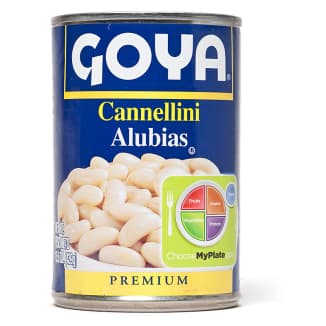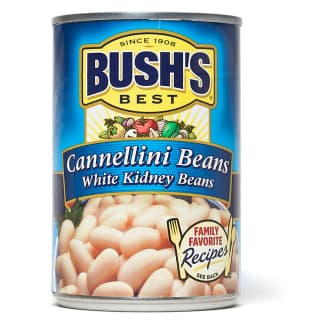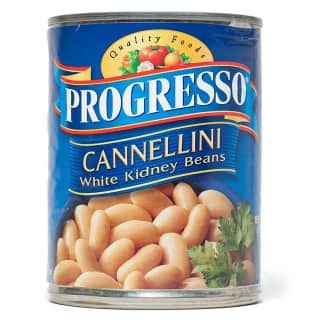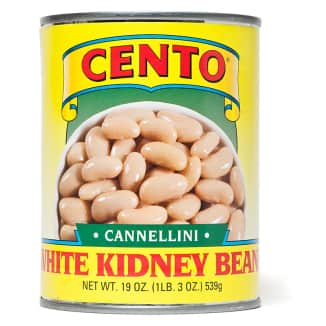Reviews You Can Trust.
See Why.
Canned White Beans
Think canned cannellini beans are no match for dried beans cooked from scratch? Today’s canning processes might just prove that notion full of beans.
Top Pick

WinnerGoya Cannellini
Tasters’ favorite canned beans were “well seasoned” (they had the highest sodium level of the lineup), “big and meaty,” and “very satisfying,” with both “earthy sweetness” and “savory flavor.” Their texture was consistently “ultracreamy and smooth,” with a “nice firm bite”—all evidence of carefully calibrated processing.
Sodium: 416 mg per 1/2-cup serving
Price at Time of Testing: $1.49 for 15.5 oz (10 cents per oz)
Tasters’ favorite canned beans were “well seasoned” (they had the highest sodium level of the lineup), “big and meaty,” and “very satisfying,” with both “earthy sweetness” and “savory flavor.” Their texture was consistently “ultracreamy and smooth,” with a “nice firm bite”—all evidence of carefully calibrated processing.
Sodium: 416 mg per 1/2-cup serving
Price at Time of Testing: $1.49 for 15.5 oz (10 cents per oz)
Sign up for the Well-Equipped Cook newsletter
Shop smarter with our ATK Reviews team's expert guides and recommendations.
What You Need to Know
We go through a lot of cannellini beans in the test kitchen. Their creamy texture and mildly nutty flavor round out soups, casseroles, pasta dishes, and salads, and they make appealing dips. Our readers love them, too. Seventy-one percent say that they regularly buy cannellini beans, outstripping the next two most popular white beans: great Northern and navy. We’ve always appreciated the convenience of canned beans for use in quick recipes and for their ability to be pureed into perfectly creamy spreads. That said, we’ve also always been a little prejudiced in favor of dried beans, considering their flavor and texture superior. They’ve been our top choice for bean-centric recipes like cassoulet and, in particular, soups, where they also lend richness and velvety texture to the broth.
As we surveyed the market to select five brands of each type, we spotted some trends. Recently, dried beans have been enjoying something of an image makeover, with home cooks and chefs snapping up mail-order heirloom varieties. We included two to see if they were truly better than plain-Jane supermarket dried beans. (Frustratingly, one maker was sold out of its popular cannellini; instead, we included a similar bean recommended by the company.) When it came to canned beans, we were happy to find that our options had grown since 2003; back then we couldn’t even find enough nationally distributed brands of cannellini beans to make a tasting, so we opened it up to all white beans. This time we had no problem assembling a lineup of cannellini beans, including one organic version that eschews preservatives and salt. Separating our lineups of dried and canned beans, we invited 21 editors, test cooks, and other staffers to gather for blind tastings six times, serving two rounds each of the beans plain, in dip, and in soup. To avoid any prejudices, we didn’t tell participants whether the beans they were evaluating were canned or dried.
A Hill of Beans
When we tallied the final results, we were shocked. Top scores for canned beans actually edged out top scores for dried beans. Sure, we disliked a few brands of canned, whose mushy textures and tinny flavors lived up to our preconceptions, but the best canned beans were excellent: firm and intact, with meltingly tender skins, creamy texture, and clean bean flavor. And above all, they were perfectly uniform.
When it came to the dried beans, the heirloom varieties stood out for flavor; tasters noticed a “clean,” “sweet” taste, almost like “chestnuts.” Supermarket dried beans were more ordinary in taste but still appealing. It was their texture that really drove down their ratings. With every batch, we followed our tested process, soaking the dried beans for 8 to 24 hours in a brine of 2 tablespoons of salt and 4 quarts of cool water and then rinsing and gently simmering them in plenty of water. But even after this careful effort, some brands of beans, despite having years left before their “best by” dates, cooked unevenly. While some brands’ beans had tender skins, others had coatings that were tough, thick, or fell off in plasticky curls. In the end, we could fully recommend only one brand of dried beans.
To confirm the results, we pitted our top canned bean against our top and bottom ranked dried beans, prepared in our Hearty Tuscan Bean Stew. The result? Our top dried bean, an heirloom variety, and our favorite canned bean were neck and neck. And what about the lowest-ranked dried bean—oddly, by the maker of our highest-ranked canned bean? It was left in the dust when it came to both taste and texture. We had our final proof: Today’s best canned beans can match—and even greatly surpass—the quality of dried beans. How? We realized we didn’t know beans about beans.
Perfect Under Pressure
Today, about 1.35 million acres of beans intended for drying are planted in the United States annually. On this scale, experts informed us, considerations of flavor are far less important compared with keeping yields high and production cheap. And remarkably, these beans are still processed pretty much the way they always have been. Bean plants themselves signal when they are ready to harvest by turning from green to gold as they dry on the stalk. Plants are cut down to finish drying and then threshed to separate the now-dried beans from pods. Historically, this was done by hand; today, machines collect the beans and chop the rest into compost. Beans to be sold dried are never washed since this would introduce moisture that could make them sprout or rot. Instead, they are passed over screens to remove stunted beans, stones, and dirt; color-sorted; and then stored in giant totes until they’re ready to be packaged.
Meanwhile, modern canning practices take bean processing to a whole new level. The exact procedure varies from brand to brand, but generally it starts with a thorough cleaning and then automatic size sorting and computerized optical inspection. In some cases if the computer spots a subpar bean, a puff of air will literally blow it right out of the production line. Then the beans are quickly blanched in hot water (similar in function to an overnight soak for dried beans) and sealed in cans with water and often salt. The salt works like a brine, not only improving flavor but also helping tenderize the skins. All but one of the canned brands we tasted add calcium chloride, which maintains firmness and prevents splitting, and calcium disodium EDTA, a preservative that binds iron in the water and prevents white beans from turning brown. (Not surprisingly, beans from one maker, the only brand that skipped the salt and preservatives, hit rock bottom in our rankings for being “inedibly” bland, with serious textural woes.) The final step is pressure-cooking the beans right in their cans. Assuming the manufacturer carefully calibrates the contents, cooking times, and temperatures, the result is consistent: perfectly cooked and intact beans.
Dried beans have another disadvantage. When their condition deteriorates, it happens invisibly. During months of storage, they can dry out too much, and this can lead to hairline cracks that split open during cooking, and it can also cause loss of flavor volatiles, leaving beans bland. In fact, the moisture level in dried beans should not drop much below 10 percent or top 18 percent, or they won’t cook evenly. Lab tests showed that only our top-rated dried bean landed within this range; all the others fell below 10 percent.
In addition to length of storage, storage conditions (including during transportation to market) also play a major role in bean quality. If dried beans are kept in a warm, moist place, they can absorb moisture and off-flavors. Heat and moisture encourage pectin and calcium to bind and harden inside the bean, a process called polymerization, while the cell walls of the skins toughen, a process known as lignification. If either of these things happens, beans cook unevenly or take forever to turn tender.
Some of our dried beans also crumbled or turned mushy too readily in the pot. This is because of the calcium content. Just as canners add calcium chloride to retain the beans’ structure, natural calcium in dried beans (determined by genetics of the beans and environmental factors like soil conditions and weather) helps them hold their shape during cooking. Lab tests confirmed that our top-ranked dried bean contained more than twice the calcium of the lowest-ranked. So it made sense that our winner stayed intact during cooking while the low-ranked beans consistently crumbled.
Beans to Buy
While tasters praised the nutty flavor and uniformly tender, intact texture of our favorite dried bean, our overall favorite bean proved to be a canned product. These well-seasoned beans (the saltiest in the lineup) were tender, creamy, and intact. But we had one last question: Could canned beans impart the same velvety richness to soups and stews that we were used to getting from dried beans?
We made two more batches of Hearty Tuscan Bean Stew with our favorite canned bean. For one batch, we followed the typical procedure, draining and rinsing the beans before adding them to the pot. For the other, we introduced the entire contents of the can, without draining. In a blind test, tasters clearly preferred the soup that included the can liquid. Soup made with drained and rinsed beans was noticeably thinner and less rich. In the batch to which we had added the whole can, the starchy liquid imparted the kind of body comparable to what we’d get when using dried beans (and the stew was not too salty). It made sense given that, essentially, the can serves as a mini cooking pot during processing. (We’ll be following up with more tests about using the can liquid.)
Our takeaway? When we really want beans with superior flavor, we’ll be glad to mail-order heirloom beans from one maker. (And when their cannellini beans are back, we’ll try those and post an update on our website. Update June 2014: Rancho Gordo has decided to stop growing Runner Cannellini beans, so we will not be tasting that variety of white bean as a followup to this story. The company will continue selling the Classic Cassoulet dried beans we tasted and recommended; see related content for our dried white beans taste test.)
That said, from here on we’re going to be using canned beans more often.
America's Test KitchenWatch Now
Everything We Tested
Recommended

WinnerGoya Cannellini
Tasters’ favorite canned beans were “well seasoned” (they had the highest sodium level of the lineup), “big and meaty,” and “very satisfying,” with both “earthy sweetness” and “savory flavor.” Their texture was consistently “ultracreamy and smooth,” with a “nice firm bite”—all evidence of carefully calibrated processing.
Sodium: 416 mg per 1/2-cup serving
Price at Time of Testing: $1.49 for 15.5 oz (10 cents per oz)
Tasters’ favorite canned beans were “well seasoned” (they had the highest sodium level of the lineup), “big and meaty,” and “very satisfying,” with both “earthy sweetness” and “savory flavor.” Their texture was consistently “ultracreamy and smooth,” with a “nice firm bite”—all evidence of carefully calibrated processing.
Sodium: 416 mg per 1/2-cup serving
Price at Time of Testing: $1.49 for 15.5 oz (10 cents per oz)

Bush's Best Cannellini Beans White Kidney Beans
“Creamy and firm,” these beans had a “beautiful appearance.” They were “plump,” “meaty” and “plush,” and “smooth and intact,” with a “nice nutty flavor and very clean bean taste.” In soup, the beans were “perfect” and kept their creamy texture and “hearty,” “beany” flavor. But these beans lost a few points because they tasted less seasoned than our winner did and had a slightly chalkier texture in the dip.
Sodium: 270 mg per 1/2-cup serving
Price at Time of Testing: $1.19 for 15.5 oz (8 cents per oz)
“Creamy and firm,” these beans had a “beautiful appearance.” They were “plump,” “meaty” and “plush,” and “smooth and intact,” with a “nice nutty flavor and very clean bean taste.” In soup, the beans were “perfect” and kept their creamy texture and “hearty,” “beany” flavor. But these beans lost a few points because they tasted less seasoned than our winner did and had a slightly chalkier texture in the dip.
Sodium: 270 mg per 1/2-cup serving
Price at Time of Testing: $1.19 for 15.5 oz (8 cents per oz)
Recommended with reservations

Progresso Cannellini White Kidney Beans
With a “mild, vegetal” flavor deemed “a tad bland and blah,” these beans were also “a bit mealy.” “Almost every bean is broken, with tough skins and grainy flesh—like mashed russet potatoes,” noted one taster. A few tasters detected a “slight sharp, canned/metallic finish.” Their softness helped make the dip “richer and creamier,” but “bits of skin” got in the way.
Sodium: 340 mg per 1/2-cup serving
Price at Time of Testing: $1.59 for 19 oz (8 cents per oz)
With a “mild, vegetal” flavor deemed “a tad bland and blah,” these beans were also “a bit mealy.” “Almost every bean is broken, with tough skins and grainy flesh—like mashed russet potatoes,” noted one taster. A few tasters detected a “slight sharp, canned/metallic finish.” Their softness helped make the dip “richer and creamier,” but “bits of skin” got in the way.
Sodium: 340 mg per 1/2-cup serving
Price at Time of Testing: $1.59 for 19 oz (8 cents per oz)

Cento Cannellini White Kidney Beans
“Creamy but blown-out,” these beans were “too mushy” and “too broken,” even in dip, where the texture resembled “baby food,” a sign that they may have been processed too long or at too high of a temperature. Some tasters found them “supermellow,” “delicate,” and even slightly “herbal,” but others said that the flavor was “pretty absent.” Tasters sometimes noted slight off-flavors of chlorine or mustiness.
Sodium: 360 mg per 1/2-cup serving
Price at Time of Testing: $2.58 for 19 oz (14 cents per oz)
“Creamy but blown-out,” these beans were “too mushy” and “too broken,” even in dip, where the texture resembled “baby food,” a sign that they may have been processed too long or at too high of a temperature. Some tasters found them “supermellow,” “delicate,” and even slightly “herbal,” but others said that the flavor was “pretty absent.” Tasters sometimes noted slight off-flavors of chlorine or mustiness.
Sodium: 360 mg per 1/2-cup serving
Price at Time of Testing: $2.58 for 19 oz (14 cents per oz)
Not Recommended

Eden Organic Cannellini White Kidney Beans, No Salt Added
Tasters hated these beans, which have no added salt, calcium chloride for firmness, or preservatives, rejecting them in every tasting. We found them “very sour,” “watery,” “flat,” “rank,” and “icky,” with “grainy interiors” and “leathery,” “tough skins.” At best, they were “inedibly bland.” Even with fresh lemon, parsley, garlic, and olive oil, the dip tasted like “chalk dip.”
Sodium: 40 mg per 1/2-cup serving
Price at Time of Testing: $2.19 for 15 oz (15 cents per oz)
Tasters hated these beans, which have no added salt, calcium chloride for firmness, or preservatives, rejecting them in every tasting. We found them “very sour,” “watery,” “flat,” “rank,” and “icky,” with “grainy interiors” and “leathery,” “tough skins.” At best, they were “inedibly bland.” Even with fresh lemon, parsley, garlic, and olive oil, the dip tasted like “chalk dip.”
Sodium: 40 mg per 1/2-cup serving
Price at Time of Testing: $2.19 for 15 oz (15 cents per oz)
*All products reviewed by America’s Test Kitchen are independently chosen, researched, and reviewed by our editors. We buy products for testing at retail locations and do not accept unsolicited samples for testing. We list suggested sources for recommended products as a convenience to our readers but do not endorse specific retailers. When you choose to purchase our editorial recommendations from the links we provide, we may earn an affiliate commission. Prices are subject to change.
Reviews You Can Trust
The mission of America’s Test Kitchen Reviews is to find the best equipment and ingredients for the home cook through rigorous, hands-on testing. Have a question or suggestion? Send us an email at atkreviews@americastestkitchen.com. We appreciate your feedback!
The Expert

byLisa McManus
Executive Editor, ATK Reviews
Lisa is an executive editor for ATK Reviews, cohost of Gear Heads on YouTube, and gadget expert on TV's America's Test Kitchen.
Lisa McManus is an executive editor for ATK Reviews, cohost of Gear Heads on YouTube, host of Cook's Illustrated's Equipment Review videos, and a cast member—the gadget expert—on TV's America's Test Kitchen. A passionate home cook, sometime waitress, and longtime journalist, she graduated from Columbia University's Graduate School of Journalism and worked at magazines and newspapers in New York and California before returning like a homing pigeon to New England. In 2006 she got her dream job at ATK reviewing kitchen equipment and ingredients and has been pretty thrilled about it ever since. Her favorite thing is to go somewhere new and find something good to eat.
Reviews You Can Trust.
See Why.








